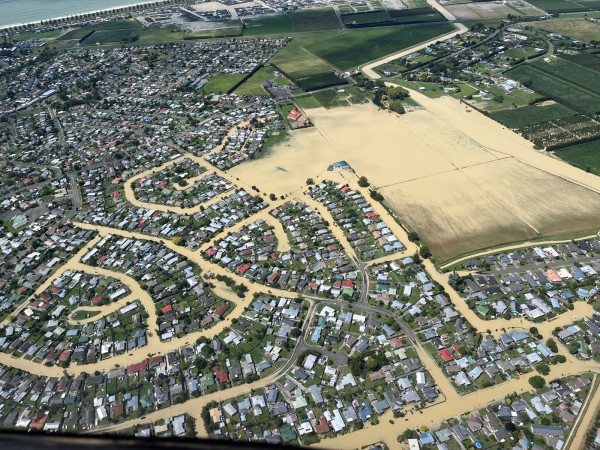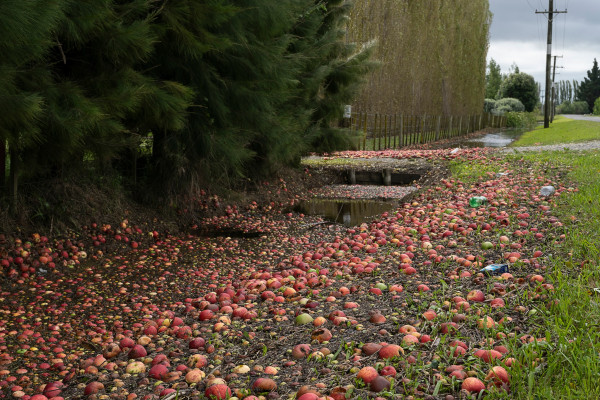Hawke’s Bay horticulture takes a massive hit in Cyclone Gabrielle
8 March 2023
At 8am the morning after the cyclone, when everything had gone quiet, Brydon Nisbet called his tenant in Puketapu to check on the state of his apple block.

An aerial view of Hawke's Bay in the aftermath of Cyclone Gabrielle
He was expecting to hear that the high winds had blown all the apples off the trees during the night. Instead to his horror, his tenant, a single mother of three, was on the roof of the house as floodwaters were rising around her.
“She was up there for seven hours. Once it had come down they made their way over orchards to a house on a hill where they stayed until Thursday when they were helicoptered out,” he said.
But the bad news didn’t stop there.
Brydon is chair of the Hawke’s Bay Fruitgrowers’ Association (HBFA) and an apple grower. He has a few blocks around the region. One, in Puketitiri was totally fine, but the two in Puketapu had both been badly impacted.
“A little block opposite this one that goes right out to the stopbank [of the Tutaekuri River] is basically flat, completely annihilated. But this one can be salvaged.”
While the apple trees are still standing, and have fruit on them, he now has to get the silt away from the trunks or they will suffocate and die. In a do-or-die operation he’s brought in diggers in an attempt to save the trees. If he does manage to save them, he might be able to salvage 40 percent of the crop.
Speaking with his industry cap on, he says growers in the broader sector have had a range of experiences.
“There are lots of people still trying to make that decision about what they are going to do. Then there are ones where there’s no hope, like my little block, and you just walk away and try to clean it up at a later date. Then there’s blocks that just got flooded but didn’t have river silt come through them. Just surface flooding. Those blocks have pumped water out so the ground can dry, but no issues with silt.”
While people are reluctant to put a figure on it, Brydon says a percentage is clearly badly affected.
“That leaves a huge amount of the sector that’s still harvesting and it’s business as usual,” he’s keen to point out. Many growers were completely unaffected and are busy picking and packing, as harvest is in full swing.
“We need those good news stories right now,” he says.
Catherine Wedd, a former apple industry director, said the cyclone couldn’t have come at a worse time – everyone was in mid-harvest. Not only have crops been lost but so have years of investment and infrastructure, technology and innovation.
“Some of the apple blocks wiped out were IP (Intellectual Property) varieties which have been bred specifically for the global markets to attract a premium. Other blocks have been set up for robotics, as the apple industry has been innovating significantly.
“There will be some big decisions over the coming months, on rebuilding and replanting crops. Our horticulture industry drives the Hawke’s Bay economy and provides jobs for so many families. The industry will need significant support to rebuild,” she says.
Catherine, who is speaking to growers every day, says many are determined to get through. The industry is strong and resilient.
“It’s important we continue to promote the New Zealand apple story to our international customers to ensure they maintain confidence in the industry here, as we produce the best apples in the world,” she says.
Berry Farms NZ, part of RD8 Fresh Produce Group, had both of its farms hit by the floods. Its Hastings farm was hit harder by water, which ranged from knee-deep to shoulder height. Sheds and the owners’ home was wrecked, says general manager Johnny Milmine.
“The irrigation shed and all electrical pumps and systems were wrecked, which meant we could not irrigate. The silt water also blocked the drippers, which means our entire raspberry farm has been wiped out.”
Its other farm in Bay View was also affected and only about 50 percent was salvageable. To make matters worse, they can’t start harvesting because they have no way to power the coolstore, and transport remains a problem.
“Guidance from MPI (the Ministry for Primary Industries) and retailers is coming through. At this time of the year we would be just starting our second harvest cycle, which would see over 120 pickers onsite. These people are now either jobless or hopefully somewhere else. It will take a full year for us to be back to where we were prior to the storm,” Johnny said.
While Hawke’s Bay is most well-known for its summerfruit, apples and pears, a lot of vegetables are grown in the Bay – tomatoes, sweet corn, peas, processed beans, leafy greens, onions, squash – mostly for export. The region is also home to vegetable growers and processors Wattie’s and McCain Foods.
Agronomist Dereck Ferguson has been conducting testing and assessments on behalf of his clients in the badly affected zone between the Ngaruroro River up to the Tutaekuri River, and also behind Awatoto on the waterfront down to Meeanee, about 6000 hectares at a rough calculation, he says.

Apple orchards were hit particularly hard, with some blocks being wiped out altogether
“This area between Meeanee and Awatoto has a contaminant problem because of the leaking sewerage [from the damaged wastewater plant], the fertiliser works and the BioRich facility.”
This infrastructure was all completely underwater in the aftermath of Gabrielle. There will be a lot of testing going forward, he says.
There are different types of silt affecting different places, some of it sandy but a lot of it more composed of clay. Some of it would be able to be incorporated into topsoil so growers could get a cover crop in and soil biology going again, even if it is very deep silt, he says.
“Those assessments need to be made paddock by paddock. Some have silt of various types and depths, and some have the top soil stripped depending on the location.”
On the whole he says vegetable operations have been hit quite badly, and of course it has knocked growers pretty hard too. But they are quite pragmatic and focussed on what they can still make an income from, as well as any immediate work that needs doing, Dereck says.
A spokesperson for the Hawke’s Bay Vegetable Growers’ Association estimated that about 2000 hectares of vegetables and cropping has been entirely decimated.
The loss of direct income from that 2000ha, more than 50 percent of total production, is in excess of $30 million. Sixty thousand tonnes of crop, of which 55,000 tonnes is edible vegetables, has been destroyed by Cyclone Gabrielle, they say.
A December 2022 update on the HBFA website written by Brydon Nisbet for growers, in what was already an incredibly wet summer, seems a fitting way to end this account of the impact of Cyclone Gabrielle:
“I recently picked up the book 100 Harvests: A History of Fruit Growing in the Hawke’s Bay which was written by Rose Mannering to celebrate HBFA’s centenary in 1999. While thumbing through this book, I reflected on some of the immense challenges our industry has previously navigated. I found former HBFA president J H Milne’s account of the 1936 season particularly poignant when he wrote “This year major calamities, including a destructive gale, a frost, and low export prices seem to be more than we can bear.”
“For additional context, the pre-season export forecast for 1936 was for 200,000 cases – the quantity exported was 9,035 (less than 5 percent). The point is that our industry is resilient, we have overcome challenges before and by pulling together, we will overcome them again.”
First published in the March 2023 issue of The Orchardist and NZGrower magazines. Author: Bonnie Flaws.
